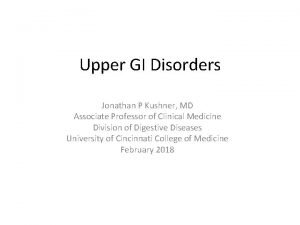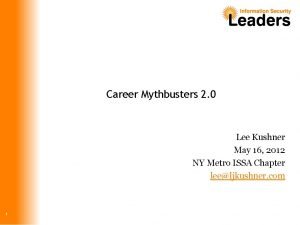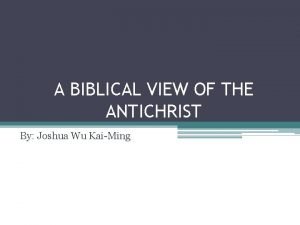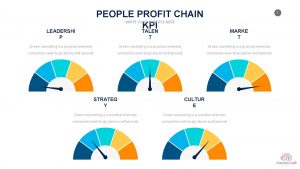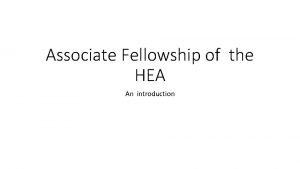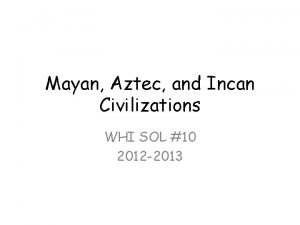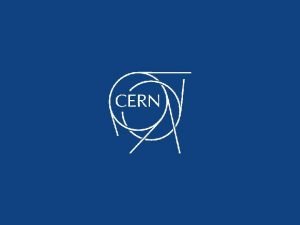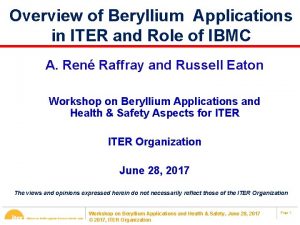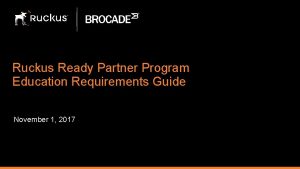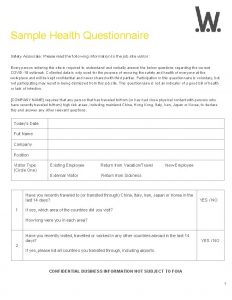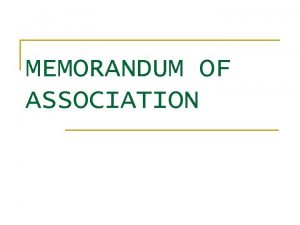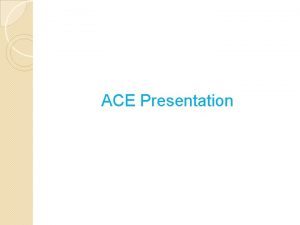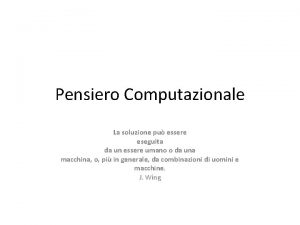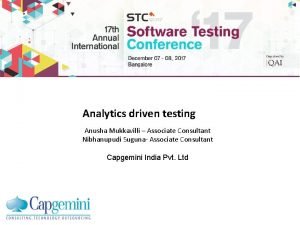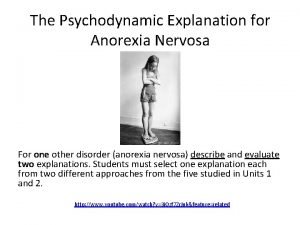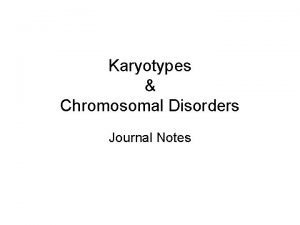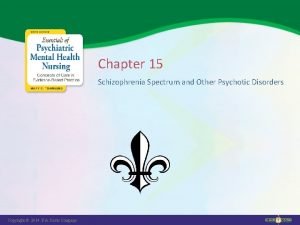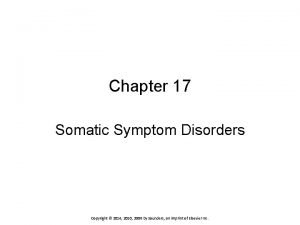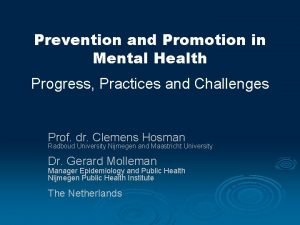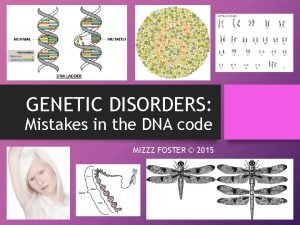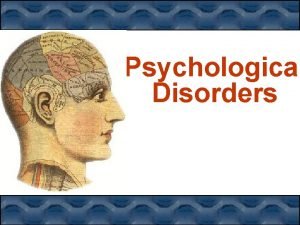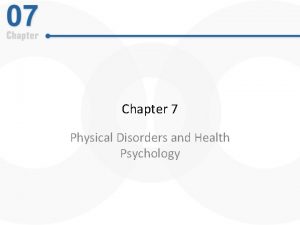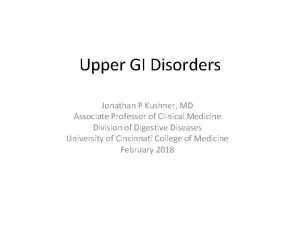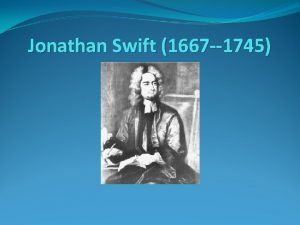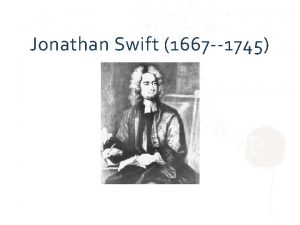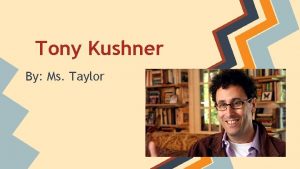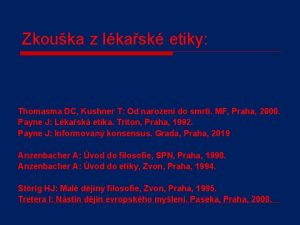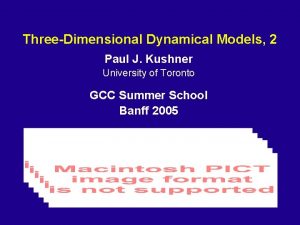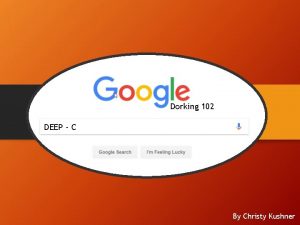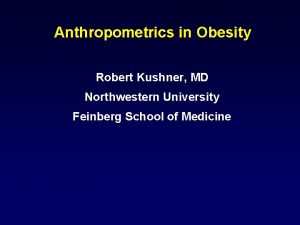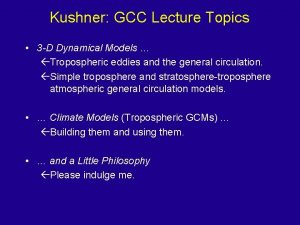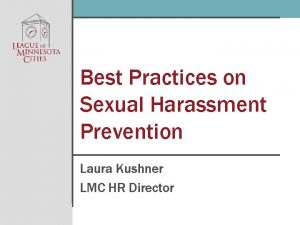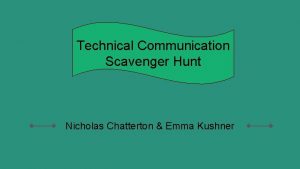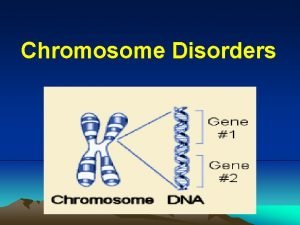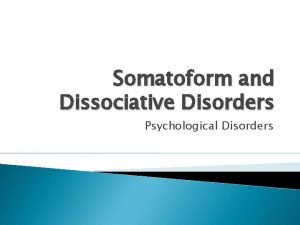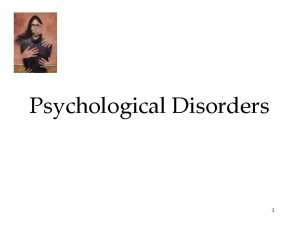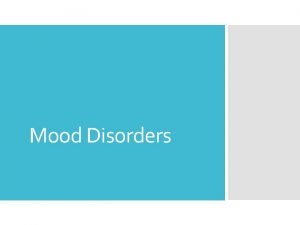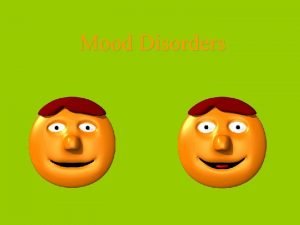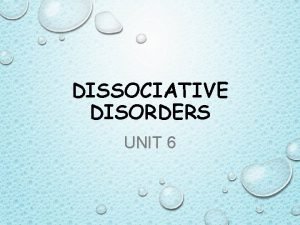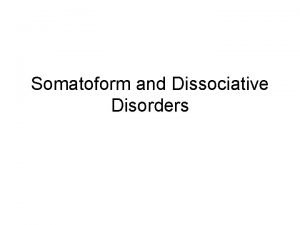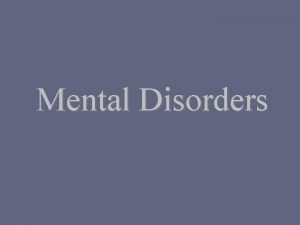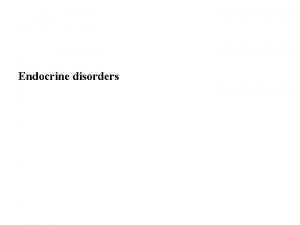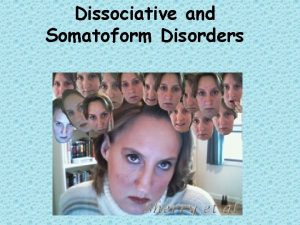Upper GI Disorders Jonathan P Kushner MD Associate






















































- Slides: 54

Upper GI Disorders Jonathan P Kushner, MD Associate Professor of Clinical Medicine Division of Digestive Diseases University of Cincinnati College of Medicine February 2018

A 25 year old male medical student complains of frequent awakening over the past few months due to burning regurgitant in his chest and mouth; he is overweight but otherwise healthy and on no medication. All of the following are likely contributors to his presentation except: A. He gets home from the hospital around 9 PM, eats a quick dinner and goes to bed B. He has developed a small hiatal hernia C. His regular consumption of orange juice each morning D. His lower esophageal sphincter relaxes frequently between meals

GERD • When the reflux of stomach contents causes troublesome symptoms and/or complications (esophagitis, bleeding, strictures, aspiration, Barrett’s/esophageal adenocarcinoma) • 10 -20% in Western world • Typical symptoms (heartburn, regurgitation); 25% monthly; 12% weekly; 5% daily; unreliable predictors of erosive disease • Most GERD is non erosive (NERD); more severe acid exposure results in erosive esophagitis (LA classification) Montreal definition and classification of gastroesophageal reflux disease (Vakil, Am J Gastro 2006)

GERD determined by: frequent LES relaxation (TLESR’s); weak LES; hiatal hernia; increased intraabdominal pressure; impaired gastric emptying; position, refluxate (acid, pepsin, bile); esophageal clearance; saliva, tissue resistance

Pathophysiology of GERD Foods that increase reflux: beer, chocolate, coffee, peppermint, fatty food Meds that may increase reflux: nitrates, progesterone, calcium channel blockers, beta agonists, anticholinergics, diazepam, alpha agonists

GERD Atypical symptoms: • • dyspepsia chest pain - GERD #1 esophageal cause of non cardiac chest pain PPI test showed diagnostic utility (vs EGD/probes) functional chest pain (Rome): non burning; no evidence GERD or dysmotility • • • asthma enamel changes cough (recumbent) hoarseness sore throat/throat clearing globus , VCD ? symptoms of laryngopharyngeal reflux (LPR); exam non specific; heartburn only in 40%/ less esophagitis; more UES issues; ? sensitive laryngeal tissue

GERD Diagnosis – PPI trial – EGD indications: alarm symptoms, Barrett’s screen, ? ? ? refractory disease – Ambulatory measure of p. H (implanted capsule) or p. H and impedance by probe on or off medication – Esophagram shows reflux in 25% of normals

GERD Therapy – Lifestyle measures (little data) – H 2 blockers (50% healing and maintenance); PPIs 90% healing/80% maintenance (take 30 -60 mins ac); PPI OK with clopidogrel (Consensus, 2010). – PPI’s - ? infection (pneumonia/C diff); fractures; B 12/Mg absorption, renal disease, dementia; AGA Mar 2017 use at lowest effective dose in complicated GERD; attempt reduction/stop in uncomplicated GERD – Antireflux surgery (fundoplication) in good responders, large hiatal hernia, predominant regurgitation; caution in others; ? magnetic sphincter augmentation system

GERD Refractory reflux : • • wrong diagnosis (cardiopulmonary, chest wall) more severe anatomy (large hernia, extremely low LES barrier) compliance, dosing, rapid metabolizer hyperacidity (ZES) primary dysmotility (achalasia) impaired gastric emptying functional heartburn/chest pain (treat antidepressants, CBT)

Upper GI Disorders A 25 year old male medical student complains of frequent awakening over the past few months due to burning regurgitant in his chest and mouth; he is overweight but otherwise healthy and on no medication. All of the following are likely contributors to his presentation except: A. B. C. D. He gets home from the hospital around 9 PM, eats a quick dinner and goes to bed He has developed a small hiatal hernia His regular consumption of orange juice each morning His lower esophageal sphincter relaxes frequently between meals

Upper GI Disorders A 25 year old male medical student complains of frequent awakening over the past few months due to burning regurgitant in his chest and mouth; he is overweight but otherwise healthy and on no medication. All of the following are likely contributors to his presentation except: A. B. C. D. He gets home from the hospital around 9 PM, eats a quick dinner and goes to bed He has developed a small hiatal hernia His regular consumption of orange juice each morning His lower esophageal sphincter relaxes frequently between meals

A 25 year old male medical student complains of frequent awakening due to regurgitant in his chest and mouth; he feels difficulty swallowing both liquids and solids in the mid chest. Which of the following descriptions seems least likely? A. B. C. D. The student in case 1 with GERD left untreated over an additional 6 months A patient whose manometric swallow study will show a non relaxing lower esophageal sphincter and aperistalsis A patient whose endoscopy will reveal many coarse rings and who will respond to swallowed topical steroids? A patient whose hands reveal sclerodactyly and telangiectasias.

Dysphagia Oropharyngeal (transfer) – Cough/choke/aspiration/nasal regurgitation; solid and liquids – Neuromuscular causes (eg myasthenia, stroke) – Structural (osteophyte, thyroid, Zencker diverticulum) – SLP evaluates with MBS or FEES

Dysphagia Esophageal Mechanical – Solids before liquids Ring, tumor; eosinophilic esophagitis (Eo. E); proximal web (Plummer Vinson/; iron deficiency); strictures (reflux, neoplasm, Eo. E, caustic ingestion); extrinsic compression Dysmotility – • Spasm - chest pain; precipitated by extreme temperature/ carbonation treat underlying GERD; warm liquids, calcium ch blockers, nitrates, sildenafil, trazadone/imipramine; Botox/dilation/surgery • Scleroderma (low LES) • Achalasia • Other – aperistalsis, jackhammer, ineffective motility

Normal high resolution contraction Achalasia – progressive liquid/solid; regurgitation; “heartburn”. Rule out secondary achalasia. Treatment: Botox; serial pneumatic dilation ~ myotomy (ACG 2013); POEM/stents/esophagectomy


Eosinophilic Esophagitis (Eo. E) • Increasing incidence; 15 % of EGD for dysphagia; M >> F; increased eotaxin 3 response to IL-13 (Th 2) • Requires symptoms, > 15 eos/hpf; absence of other conditions • Atopy in 50%; peripheral eos in 30% • PPI responsive > 30% • Topical swallowed steroids - complete histo response 60 -70% • Elemental diet 90% effective; SFED 70% (especially milk/wheat in adults) • Cautious dilation successful in > 85%, with low perforation rate • ? endpoints in adults

Odynophagia Inflammation/infections • Infections mostly in immunocompromised – Candida >> viral HSV/CMV • Pill esophagitis – cyclines, KCl, bisphonate, vit C; take all pills upright

Upper GI Disorders A 25 year old male medical student complains of frequent awakening due to regurgitant in his chest and mouth; he feels difficulty swallowing both liquids and solids in the mid chest. Which of the following descriptions seems least likely? A. The student in case 1 with GERD left untreated over an additional 6 months B. A patient whose manometric swallow study will show a non relaxing lower esophageal sphincter and aperistalsis C. A patient whose endoscopy will reveal many coarse rings and who will respond to swallowed topical steroids? D. A patient whose hands reveal sclerodactyly and telangiectasias.

Upper GI Disorders A 25 year old male medical student complains of frequent awakening due to regurgitant in his chest and mouth; he feels difficulty swallowing both liquids and solids in the mid chest. Which of the following descriptions seems least likely? A. The student in case 1 with GERD left untreated over an additional 6 months B. A patient whose manometric swallow study will show a non relaxing lower esophageal sphincter and aperistalsis C. A patient whose endoscopy will reveal many coarse rings and who will respond to swallowed topical steroids? D. A patient whose hands reveal sclerodactyly and telangiectasias.

Upper endoscopic esophageal screening should be performed in which patient? A. B. C. D. A 20 year old African American male with nightime regurgitation about once a month after late dinner/work conferences An asymptomatic 49 year old Caucasian bus driver who achieved excellent control of longstanding nighttime reflux after starting a once daily PPI 3 years ago. A 30 year old alcoholic Caucasian female with a normal CBC A 25 year old Haitian man whose dyspepsia has resolved after recent therapy for H pylori found on stool testing

Biopsy if > 1 cm Z line variability (ACG Guidelines 2015)

Barrett’s esophagus • 600 fold increase in adeno. CA of esophagus over 25 years; ? increased GERD, refined food, ? hr – HPV; decreased H pylori • Barrett’s 1. 5 - 7% of Western populations • Risk estimates of CA in non dysplastic Barrett’s have declined to 0. 12% (? predictors may include hr HPV, p 16/p 53 inactivations, long segment Barrett’s) • Screen Males with chronic(> 5 yr) frequent (weekly) GERD and 2 or more risks (> 50, Caucasian, smoker, waist > 102 cm (abd adiposity); family hx (ACG 2015); ? ? hiatal hernia Females only if multiple risks

Barrett’s esophagus Survey Barrett’s metaplasia at 1 year, then every 3 -5 yrs; low grade dysplasia every 6 -12 months. Therapy GERD/PPI; ? roles for ASA/NSAIDs/statins Growing evidence for radiofrequency ablation (RFA) of LGD (Phoa, JAMA 2014, reduced progression from 26 to < 2%); and HGD. EMR and RFA in intramucosal CA above the m. mucosa

Esophageal Cancer • Adenocarcinoma superseded squamous cell cancer in the past 2 decades in the US • Risks for squamous cell CA – achalasia/stasis, tylosis, PVS, lye ingestion, radiation, smoking, alcohol, HPV

Esophageal Cancer • Esophageal CA staging after biopsy confirmation • CT scan +/- PET scanning to exclude metastatic disease, then EUS for local staging • More than half of patients present with at least locally advanced disease precluding initial surgical cure, and impacting prognosis

Upper GI Disorders Upper endoscopic esophageal screening should be performed in which patient? A. A 20 year old African American male with nightime regurgitation about once a month after late dinner/work conferences B. An asymptomatic 49 year old Caucasian bus driver who achieved excellent control of longstanding nighttime reflux after starting a once daily PPI 3 years ago. C. A 30 year old alcoholic Caucasian female with a normal CBC D. A 25 year old Haitian man whose dyspepsia has resolved after recent therapy for H pylori found on stool testing

Upper GI Disorders Upper endoscopic esophageal screening should be performed in which patient? A. A 20 year old African American male with nightime regurgitation about once a month after late dinner/work conferences B. An asymptomatic 49 year old Caucasian bus driver who achieved excellent control of longstanding nighttime reflux after starting a once daily PPI 3 years ago. C. A 30 year old alcoholic Caucasian female with a normal CBC D. A 25 year old Haitian man whose dyspepsia has resolved after recent therapy for H pylori found on stool testing

A 28 year old computer programmer born in Bellevue, Washington, complains of a mild epigastric fullness, intermittently since college, particularly when eating out. He denies typical GERD symptoms. He also denies regular NSAID use or other medications. He has gained about 5 pounds this year due to reduced physical activity. He wants to know if an upper endoscopy should be done. You suggest: A. Stool antigen test for H pylori with treatment if positive B. Gastric emptying study at Nuclear Medicine C. Reassurance, a diet diary and a follow up visit in 3 months to evaluate further diagnostic/therapeutic options D. Start PPI acid suppression twice per day with an upper endoscopy next week to exclude peptic ulcer

Dyspepsia • Symptoms attributed to the luminal upper GI tract, often related to ingestion – discomfort/pain; fullness/satiety; (bloating, nausea); affects up to 40% of population • Clinically exclude carbohydrate intolerance, SIBO, malabsorption/celiac, ischemia/vascular disease, pancreatic/biliary disease, aortic aneurysm, cardiopulmonary disease • Majority is functional dyspepsia (FD); less commonly attributed to non erosive GERD, peptic ulcer disease, medication induced dyspepsia, gastroparesis, neoplasm, infiltrative diseases, metabolic • Alarm symptoms – anemia, vomiting, weight loss and/or age > 55 should prompt upper GI imaging (EGD)

Dyspepsia Management options: (in absence of red flags or < 55 yo) • Investigate/imaging • Test and treat H pylori; NNT = 17 for response; cost effective if > 12% prevalence • PPI’s/acid suppression • Buspirone, low dose nortriptyline, mirtazepine • Psychology, reassurance

Nausea/Vomiting in Adults (differentiate vomiting from free regurgitation, rumination) Uncommon CNS • Benign Positional Vertigo • Migraine • Motion Sickness • Cyclic Vomiting Syndrome/Cannabis Hyperemesis GI • GERD • PUD/gastritis • Gastroparesis • Biliary/pancreatic • Appendicitis Infections • Bacterial/viral gastroenteritis/Foodborne • Pyelonephritis Metabolic • DKA, pregnancy, uremia CNS • stroke, seizure, mass, pseudotumor, Meniere’s, meningitis, hydrocephalus, trauma GI • adhesions, hernia, obstruction, ischemia, peritonitis, dysmotility Infections • CNS (abscess, encephalitis, meningitis), pneumonia Metabolic • adrenal, parathyroid, thyroid Other: kidney stones, myocardial infarction, glaucoma medications/toxins/withdrawal, pain, psych

Nausea and Vomiting Classes of antiemetic agents: Anticholinergic: Scopolamine Antihistamine: Meclizine, hydroxyzine Phenothiazine: Prochlorperazine, promethazine Benzamide: Trimethobenzamide, metoclopramide Butyrophenone: Droperidol Serotonin (5 -HT 3) antagonist: Ondansetron, granisetron Neurokinin-1 antagonist: Aprepitant Corticosteroid: Dexamethasone Benzodiazepine: Lorazepam, diazepam Cannabinoid: Dronabinol

Gastroparesis • Nausea/satiety/fullness; vomiting, bloating, pain in more severe (overlap with dyspepsia); bezoars • Idiopathic > diabetes > other etiologies • EGD/imaging to exclude obstruction • Diagnosis: Gastric emptying study > 60% retention at 2 hrs; > 10% at 4 hours (other: capsule, sonography, MRI, 13 C breath tests) adjust meds, glucose control • Symptom correlation with gastric emptying studies poor

Gastroparesis Treatment (2013 ACG): - diet (liquid predominant !) - glucose control antiemetics prokinetics (metoclopramide OK) gastric electrical stimulation (diabetics) acupuncture Botox (not routinely recommended) feeding tubes/surgery

Gastritis/H. Pylori • Autoimmune (type A) gastritis; gastric body predominant; associated pernicious anemia, hypochlorhydria, type I carcinoids, adenocarcinoma • H Pylori o Type B, antral predominant. o H pylori prevalence in West 20%; decreasing o Assess H pylori status in documented PUD, MALT B cell lymphoma, early gastric CA, pre ASA/NSAID use; ? in IDA, FD, ITP, chronic urticaria o False negative (stool, breath) testing possible with PPI or antibiotic use; active bleed o Serology does not reflect persistent infection

H. Pylori Therapy: • Amoxicillin, tetracycline, bismuth do not develop resistance • If no macrolide exposure and clarithramycin resistance < 15%: amoxicillin/clarithramycin/PPI for 14 days • Otherwise: Tetracycline/Bi+/Flagyl/PPI; or sequential amox 5 d, then clarith/flagyl 5 d; or amox + levo or amox + cipro+ rifabutin (Toronto/AGA 2016; ACG 2017)

Upper GI Disorders A 28 year old computer programmer born in Bellevue, Washington, complains of a mild epigastric fullness, intermittently since college, particularly when eating out. He denies typical GERD symptoms. He also denies regular NSAID use or other medications. He has gained about 5 pounds this year due to reduced physical activity. He wants to know if an upper endoscopy should be done. You suggest: A. B. C. D. Stool antigen test for H pylori with treatment if positive Gastric emptying study at Nuclear Medicine Reassurance, a diet diary and a follow up visit in 3 months to evaluate further diagnostic/therapeutic options Start PPI acid suppression twice per day with an upper endoscopy next week to exclude peptic ulcer

Upper GI Disorders A 28 year old computer programmer born in Bellevue, Washington, complains of a mild epigastric fullness, intermittently since college, particularly when eating out. He denies typical GERD symptoms. He also denies regular NSAID use or other medications. He has gained about 5 pounds this year due to reduced physical activity. He wants to know if an upper endoscopy should be done. You suggest: A. B. C. D. Stool antigen test for H pylori with treatment if positive Gastric emptying study at Nuclear Medicine Reassurance, a diet diary and a follow up visit in 3 months to evaluate further diagnostic/therapeutic options Start PPI acid suppression twice per day with an upper endoscopy next week to exclude peptic ulcer

Your patient’s colleague also presents for an evaluation. He has missed work 6 times in the past year for periods of severe nausea, mild abdominal discomfort and emesis with volume depletion. The episodes last around a week; when they resolve he feels fairly normal, eats regularly again, and regains weight lost. A. Ask if anyone in his family suffers from migraine headaches B. Send HLA typing to exclude celiac disease C. Inquire as to any use of marijuana D. Discuss a trial of amitriptyline at bedtime

Upper GI Disorders Your patient’s colleague also presents for an evaluation. He has missed work 6 times in the past year for periods of severe nausea, mild abdominal discomfort and emesis with volume depletion. The episodes last around a week; when they resolve he feels fairly normal, eats regularly again, and regains weight lost. You might do all but the following: A. B. C. D. Ask if anyone in his family suffers from migraine headaches Send HLA typing to exclude celiac disease Inquire as to any use of marijuana Discuss a trial of amitriptyline at bedtime History very suggestive of Cyclic Vomiting Syndrome

Upper GI Disorders A 59 year old male undergoes an upper endoscopy for persistent dyspeptic symptoms and mild microcytic anemia. He had a normal colonoscopy last year. He takes low dose aspirin daily for known coronary artery disease and admits to using Advil at least 4 days a week for right knee pain. The EGD reveals a 1. 5 clean based ulcer in the duodenal sweep. You should: – – Admit him directly for IV PPI therapy Begin oral PPI therapy to continue indefinitely Schedule a follow up EGD for 8 weeks to assess ulcer resolution Omit H pylori testing in this case since he admitted to NSAID use

Peptic Ulcer Disease § Prevalence remains high as H pylori declines, NSAID use rises (> 70% over 65 at least weekly); OTC’s. § Idiopathic (20%) increasing; recheck drug history/H pylori; consider Crohn’s, CMV, ischemia/cocaine, Zollinger Ellison, infiltrative, neoplasm § 80% of NSAID ulcer complications present without warning symptoms § H pylori eradication heals DU, GU and prevents recurrence

NSAID Co Protection

Upper GI Bleeding - Etiology • • • Peptic ulcer Mucosal lesion/erosion Portal HTN/varices Mallory Weiss Gastritis/esophagitis/erosive gastropathy Dieulafoy lesion Neoplasm GAVE Angiodysplasia Aortoenteric fistula Hemobilia

UGI bleeds (ASGE guidelines 2012) • Mortality unchanged ~ 10% • Bright red hematochezia from upper source only if hemodynamically unstable • First steps; IV access/resuscitation, cardiac assessment, ? intubation • Intervention – for high Blatchford score vs risk factors of cirrhosis/malignancy/red hematemesis, hypotension/tachycardia/Hb < 8

UGI bleeds (ASGE guidelines 2012) • For PUD, PPI started before endoscopy reduces intervention; use octreotide/antibiotics in suspected portal HTN • IV prokinetics 20 -120 min before endoscopy decreases need for 2 nd look • Early EGD (24 hrs) reduces LOS/transfusions; rebleeding reduced to < 20% with endotherapy, < 10% with concomitant PPI therapy, especially if continued for 72 hrs; 2 nd look beneficial for rebleeding • ICU stress ulcers: prophylax ventilated/anticoagulated patients

Stigmata of Ulcer Hemorrhage Prediction of Rebleeding Arterial Bleeding (16%) Visible Vessel (22%) 88% rebleed 50 -70% rebleed Adherent Clot (15%) 9 -36% rebleed Flat pigmented spot (15%) Clean base (33%) 0 -10% rebleed 3% rebleed

A 59 year old male undergoes an upper endoscopy for persistent dyspeptic symptoms and mild microcytic anemia. He had a normal colonoscopy last year. He takes low dose aspirin daily for known coronary artery disease and admits to using Advil at least 4 days a week for right knee pain. The EGD reveals a 1. 5 clean based ulcer in the duodenal sweep. You should: A. Admit him directly for IV PPI therapy B. Begin oral PPI therapy to continue indefinitely C. Schedule a follow up EGD for 8 weeks to assess ulcer resolution D. Omit H pylori testing in this case since he admitted to NSAID use

Upper GI Disorders A 59 year old male undergoes an upper endoscopy for persistent dyspeptic symptoms and mild microcytic anemia. He had a normal colonoscopy last year. He takes low dose aspirin daily for known coronary artery disease and admits to using Advil at least 4 days a week for right knee pain. The EGD reveals a 1. 5 clean based ulcer in the duodenal sweep. You should: – – Admit him directly for IV PPI therapy Begin oral PPI therapy to continue indefinitely Schedule a follow up EGD for 8 weeks to assess ulcer resolution Omit H pylori testing in this case since he admitted to NSAID use

Gastric Cancer • Decreased incidence adenocarcinoma in 20 th century, though still 4 th leading cancer cause of death in world; decrease ? due to reduced salt/nitrate/smoked food, H pylori and/or smoking. • Intestinal type most common, linked to H pylori/atrophy/intestinal metaplasia; increased HEGFR 2, c-met oncogene expression; reduced p 53 suppressor. § Diffuse type more aggressive; associated with CDH 1 mutations and loss of E- cadherin adhesion protein • Only ¼ at presentation appear to have locoregional disease suitable for curative resection

Gastric Cancer • Symptoms: gastric symptoms, pseudoachalasia, iron deficiency, Virchow or Sister Mary Joseph node, Kruckenberg ovary, Bruner’s shelf, A. nigricans, hypercoaguable state • CT scan to eliminate distant mets then EUS +/- laparoscopy to stage before therapy • Screening: little consensus in US - ? surveillance of intestinal metaplasia (perhaps with risks: family history, polyposis syndromes, PA)

Other Gastric Lesions • Fundic gland polyps – most common; not concerning unless FAP • Low malignant potential: hyperplastic, hamartomatous, inflammatory fibroid polyp (unless dysplasia present) • MALT lymphoma • Menetrier’s disease • Zollinger Ellison • Leiomyoma (in musc propria) ; < 3 cm observe • GIST • Lipoma (from submucosa) • Carcinoid (submucosal) – most related to type A gastritis • Granular cell tumor (from Schwann cells) • Pancreatic rest

 Dr jonathan kushner
Dr jonathan kushner Lee kushner
Lee kushner Diana kushner lanis
Diana kushner lanis Justin trudeau antichrist
Justin trudeau antichrist Marine corps league uniform regulations
Marine corps league uniform regulations Physician associate lecturer
Physician associate lecturer Customer kpi
Customer kpi Hea associate fellowship
Hea associate fellowship The pyramid at chichen itza is most closely associate with
The pyramid at chichen itza is most closely associate with Critical reading active
Critical reading active Rcog associate
Rcog associate Mhp associate partner gehalt
Mhp associate partner gehalt Cincinnati state associate degrees
Cincinnati state associate degrees Cern hid
Cern hid Iter project associate
Iter project associate Bcs student membership
Bcs student membership Cipd experience assessment impact report examples
Cipd experience assessment impact report examples Associate consultant in capgemini
Associate consultant in capgemini Lone star college nursing deadlines
Lone star college nursing deadlines برنامهxx
برنامهxx Rekenhulp tegemoetkoming scholieren
Rekenhulp tegemoetkoming scholieren Partner portal ruckus
Partner portal ruckus Safety associate
Safety associate Imeche associate membership
Imeche associate membership Associate degree netherlands
Associate degree netherlands Aad program
Aad program Promotion from associate professor to professor
Promotion from associate professor to professor Name something you associate with superman
Name something you associate with superman Associate program
Associate program Sep certification
Sep certification Associate degree rmit
Associate degree rmit Associate director meaning
Associate director meaning Definition of memorandum of association
Definition of memorandum of association Associate warden
Associate warden To associate
To associate Laser alignment
Laser alignment Tecniche associate al pensiero computazionale:
Tecniche associate al pensiero computazionale: Los angeles harbor college culinary arts
Los angeles harbor college culinary arts Child development program director permit
Child development program director permit Associate consultant in capgemini
Associate consultant in capgemini Set-associative mapping advantages disadvantages
Set-associative mapping advantages disadvantages Adobe spark certificate
Adobe spark certificate Harper college
Harper college Psychodynamic explanation of anorexia
Psychodynamic explanation of anorexia Emotional disturbance assistive technology
Emotional disturbance assistive technology Difference between mendelian and chromosomal disorders
Difference between mendelian and chromosomal disorders Chapter 18 psychological disorders
Chapter 18 psychological disorders Looseness of association example
Looseness of association example Neurocognitive disorders
Neurocognitive disorders Chapter 17 somatic symptom disorders
Chapter 17 somatic symptom disorders Mental health disorders
Mental health disorders Chromosomal mutation
Chromosomal mutation Dsm v personality disorders
Dsm v personality disorders Types of dissociative disorders
Types of dissociative disorders Physical disorders and health psychology
Physical disorders and health psychology
